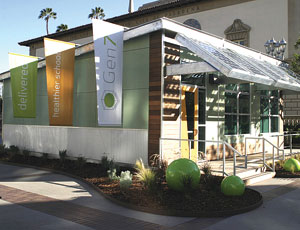Getting energy-efficient design into school construction can be tough, but the Gen7 modular-classroom building from American Modular Systems, Manteca, Calif., fits many of the latest energy-efficiency advances into one package, bringing the cutting edge of green technologies to modular school construction.

Introduced at the Green California Schools Summit 2009 in Pasadena, Calif., in December, Gen7 is being touted as a “grid-neutral” modular-classroom solution for California school districts.
“Gen7 is a loaded model, with every possible option,” says Tony Sarich, vice president of operations for AMS. “It’s not the best plan for every school, but it is intended to show that the technology is finally there.” While each Gen7 building sports a 6-kW rooftop solar-panel system, the grid-neutral claim is due mainly to energy-efficient design.
“The extent to which [AMS] were willing to go was more than the norm,” says Chuck Shinneman, director of sustainability and optimization for Capital Engineering, Rancho Cordova, Calif., which modeled performance scenarios for Gen7 and made energy-efficiency suggestions. “Gen7 more than met net-zero in our studies.”
The building features Lutron dimmable lighting controls with sensors that dynamically adjust classroom lighting to maximize daylighting. A variable-refrigerant-flow, split-design HVAC system from Mitsubishi Electric boasts lower energy use, quieter operation and improved indoor air quality over comparable rooftop-mounted systems.
The absence of gypsum- or formaldehyde-based materials contributes to low VOC levels. A polystyrene thermal envelope prevents thermal bridging. The cladded wall system requires no paint. Green construction materials include denim-based insulation, a high-fly-ash-content concrete floor, 80%-recycled structural steel and 100%-recycled mineral-board sheathing for roof and wall backing.
Getting all these technologies into a modular design presented some challenges, says Shinneman. “The split-system [AC] was more expensive, but in addition to its energy benefits, the fact is that the module has to go under overpasses during transport and the height limit prevented the use of roof-mounted equipment.”
As AMS plans to market Gen7 across California, it was necessary to model Gen7’s performance across all sixteen climate zones as defined by the state’s Title 24 energy-efficiency standards. Gen7 surpassed Title 24 performance requirements by an average of 30%. More infomation is at www.gen7schools.com.



Post a comment to this article
Report Abusive Comment